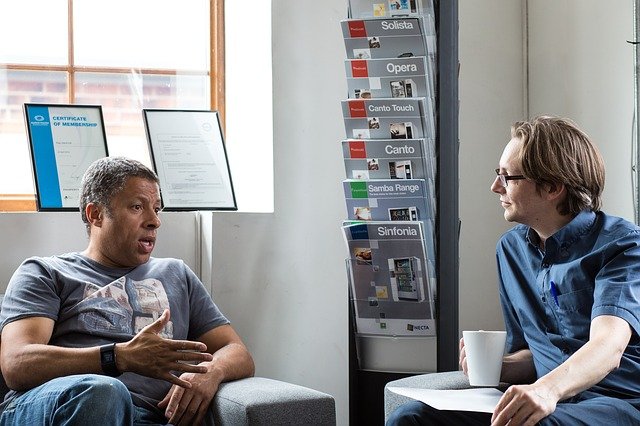As a mentee, all you need to do is ask a few questions from someone with experience, and as a mentor, all you need to do is give a few helpful tips…right? It’s often not that simple, especially when the mentoring relationship is focused on talent development within an organizational setting. The path you take to build a successful mentor relationship that actually meets the needs of mentee and mentor alike is almost just as important as the mentoring relationship itself. Quite often, taking a structured approach to building mentoring relationships improves the success rate of the relationships.
How to Build a Successful Mentor Relationship
To be sure, there are different types of mentors and different types of mentoring relationships, but that’s all the reason to think deeply about the end goals. Building a successful mentoring relationship will hinge in no small way on the reason why you’re entering into the mentoring relationship in the first place.
Here are 5 steps we recommend to build a successful mentoring relationship:
- Discuss the purpose and end goal of the mentoring relationship
- Have the mentee perform a self-assessment, or have the mentor prepare a relationship game plan
- Create a regular meeting schedule
- Identify successes and roadblocks where and when they occur
- Measure success in whichever way you’ve determined prior to starting the mentoring relationship like progress toward the end goal
This is by no means the only way to map out a mentoring relationship that will lead it to success. However, this guide should point you in the right direction. Let’s explore these steps in a bit more detail.
That might seem “backward”, but in reality, it’s actually the more straightforward approach to engaging in mentoring relationships or any type of engagement that’s educational in nature.
The University of Illinois also calls it “Big Picture Planning”, and gives three broad action steps for this type of design plan:
- Identify desired results
- Determine acceptable evidence
- Plan the learning experience and instruction
Simple enough, right? Now let’s apply that to a mentoring relationship. Good mentoring relationships begin with an end in mind. So consider:
- What do you (as the mentee) want to see as the outcome of the mentoring relationship?
- Based on that outcome, what does success look like for you?
- What type of engagements during your mentoring relationship will help you get there?
The reason why this structure works so well for mentoring relationships is that, at its core, mentoring is a type of knowledge transfer, just like classroom teaching or coaching. In any situation where knowledge (or experience) is getting transferred from one individual to another over a sustained period, efficiency is established when everyone is on the same page regarding what and how information is to be shared.
For a better understanding of goal setting in mentoring relationships, we highly recommend you read more about REAL Goals (as an alternative to SMART Goals) including how to create them and how goals are different from objectives.
2. Self-Assessments and Game Plans
Traditional mentoring relationships are typically mentee-led, but the mentor and mentee should have some idea of what they plan to do during that relationship. This is why it’s important for mentees to do a self-assessment to understand what they need out of the mentoring relationship, and for mentors to create a game plan for how they will assist the mentee in closing those knowledge or skills gaps.
Pro Tip: Get the most out of your self-assessment by reviewing it with your manager or another leader within your organization who’s directly responsible for your development. This will help ensure that your mentoring relationship is properly aligned and helps validate that you’re working on goals that will produce the results that benefit you and your organization. What’s more, sharing your self-assessment results will help your manager understand how best to serve your needs, and allow them to focus on ways to offer extra insight and motivation for your mentoring goals.
Mentee self-assessments
Self-assessments don’t have to be formal, but they should be specific. Both the mentee and the mentor will get very little value out of the relationship if the mentee doesn’t have any idea what the end goal is. More likely than now, if you’re the mentee and you’re hoping to build a great relationship with a mentor, you likely have at least some idea of what you want to get out of the engagement.
- Situational: Skills or knowledge that you need for certain situations, or that skills that arise due to a specific situation. For example, if you were recently promoted, you may need some mentoring on how to get acclimated to a leadership role. Or, you may have been asked by a manager to plan an event, but you need some additional guidance from a more experienced member of your team who has planned events successfully in the past.
- Tacit skills: Skills you pick up just from observing someone else. This may be a direct or indirect form of mentoring and could be based on the talents you’ve simply observed in someone else that you’re adopting or mimicking. This can even be accomplished just by asking someone who has those skills if you can observe them in action.
It’s a good idea to come prepared for your first meeting with your mentor having a few big goals in mind, based on what you’ve identified as your needs. Because that person is presumably more experienced in the area you hope to improve in, he or she will likely be able to identify additional goals that would be valuable to add to your list.
Mentor game planning
As the mentor, your mentee will hopefully have indicated prior to your first meeting a few thoughts about what skills, knowledge, or experience you have that they find valuable and shareable. That could be something as simple as…
“Hey, I’m a new hire and you’ve been here for years, can you help me get better situated with the company?”
Or as complex as…
“I see you’ve successfully landed 10 clients in the past year. I’ve been struggling to land one. Can you help me better understand what I’m doing wrong, and how you find success?
In both cases, you should start planning out your first and potentially subsequently interactions by focusing on two things:
- What gaps in knowledge or skills do you think the mentee might have?
- How can you best leverage your experience to help the mentee reach his or her goals?
While it might be tempting, you may want to avoid leading the discussion, especially during the first meeting with your mentee. Ask appropriate open-ended questions that help elicit the mentee to elaborate on what gaps of knowledge exist and what goals are needed to fill them. From there, share what you think might help the mentee, and work together to formulate a game plan for how to get your mentee to where he or she wants to be.
3. Create a Regular Meeting Schedule
Building a successful mentoring relationship is only possible when mentors and mentees block off time to meet and discuss progress. We highly recommend you don’t let this be a spur-of-the-moment thing. When launching a mentoring relationship, both parties have a responsibility to respect each other’s time, but also to ensure that the relationship is ultimately fruitful.
That begs two important questions:
- How long should mentoring relationships last?
- How often should mentors and mentees meet?
The answer to questions is this: It depends on the reason you’re in a mentoring relationship.
Let’s take onboarding as a great example of common mentoring relationships.
Onboarding programs with peer mentoring relationships are exceptionally common in most organizations these days. New hires get the benefit of “learning the ropes” from more experienced team members, while also forming the type of connections that are essential to improving retention rates.
These programs for new hires can be a month or up to a year. It depends on how quickly the organization needs those individuals to begin fully contributing to the team. Obviously, rushing through the process is detrimental, which is why at least one study on onboarding times suggests stretching it out to a year for better retention.
Nevertheless, during the onboarding period, mentors and mentees will likely meet at regularly scheduled intervals, or at intervals that both agree to. Ultimately, though, the onboarding program ends, and so does that mentoring relationship.
It’s important for individuals to have access to both formal and informal mentoring opportunities. Successful mentoring relationships are established within either of the formats, but only when both parties understand how long that relationship is going to last, and establish a structure to how and when meetings will occur.
4. Identify and Address Successes and Roadblocks
Good mentoring relationships are often an uphill battle. Mentees are going to try new things. Sometimes, they’ll fail in the process. Sometimes they’ll succeed splendidly. It’s important to acknowledge both. Celebrate the wins. Discuss and strategize about the failures.
A 2013 study on mentoring published in Academic Medicine found that in successful mentoring relationships, mentors and mentees tended to exhibit certain traits that distinctly relate to these milestones.
For mentees, the most commonly-mentioned traits were being open to feedback and being an active listener. For mentors, the single best trait that predicted success in a mentoring relationship was altruism.
Although the dynamic in most mentoring relationships should learn toward the mentee, there’s a realistic understanding that the mentee is there to learn. As such, mentees should be open and honest about what’s happening regarding meeting goals, and be willing to accept feedback and advice as necessary to improve.
Mentors, on the other hand, should not make the mentoring relationship about themselves. Focus on the mentee’s needs and the mentee’s goals. Don’t view the mentee as someone you can leverage later for your own personal goals. Instead, dedicate your time to helping your mentee understand missteps, plot out paths to improvement, and continue working toward measurable goals.
It’s important to keep in mind that a successful mentoring relationship is about development. Development is hard to achieve if you’re not actively reflecting on both roadblocks and big wins. Both provide valuable information that mentees can use to reach their goals.
5. Measure Success in Mentor Relationships
We’ll preface this last section here by saying that there are many ways to measure success. If we’re talking about an employee mentoring relationship, success may be measured through:
- Lower turnover rates
- Improved retention rates
- Increased employee satisfaction
- Cost savings
As well, the measurement will focus on a return on investment for the mentoring program that you’re using to establish and monitor the mentoring relationships you’ve established in the organization.
That said, the way you measure success (and what success actually looks like) is completely dependent on the measurement standards you created at the outset of the mentoring relationship (or mentoring program). For some mentoring relationships, success could be:
- Task-oriented: “I read all of the onboarding material completed all my onboarding modules”.
- Business-oriented: “We reduced our employee turnover rate from 12% to 8% year-over-year”.
- Talent-focused: “My mentee successfully held his first meeting with C-Suite executives and received positive feedback.”
Again, the big picture for measuring success is that you A) established what success should look like at the outset of your mentoring relationship (or more broadly, before launching a mentoring program), and B) you created a way to measure success.
Regardless of which method you’re using to measure success, make sure you commit to gathering and measuring data and then using that data as actionable insight. Measuring success is fairly pointless if you don’t plan on doing anything with that information. Once you’ve measured your success, turn that information around into something useful, such as expanding into new mentoring relationships or launching new programs, improving existing programs, or developing strategies and next steps for exiting mentoring relationships or mentoring programs.
Build Successful Mentoring Relationships through Mentoring Software
As we explained above, successful mentoring relationships are typically purposefully structured, and distinctly measurable. For organizations launching mentoring programs, the easiest way to accomplish that is through mentoring software. MentorcliQ’s award-winning mentoring software has everything you need to build the type of mentoring relationships that lead to repeatable and verifiable success.
- Quickly add participants with HRIS integration
- Allow participants to create detailed profiles backed by Nobel prizing-winning personality matching algorithms
- Automate matching based on best-fits, or identify leverage algorithm-based match recommendations for individuals mentor/mentee pairings
- Create as many mentoring programs as you need, with as many participants as you want
- Dramatically reduce turnover and increase retention by as much as 75% among mentoring program participants
Hundreds of organizations, including Chase, Cigna, and The Clorox Company have built and sustained programs using MentorcliQ’s mentoring software. Organizations that start programs with MentorcliQ find it helps their participants build the kind of successful mentoring relationships that produce results, which is why over several organizations, such as Nielsen, KeyBank, and Bacardi have gone on to win awards for the mentoring programs they’ve created that leverage MentorcliQ software.
Learn more about how MentorcliQ works today and book a demo to see why Fortune 500 and Fortune 1000 companies are leveraging our mentoring software to solve some of their biggest talent development challenges.








